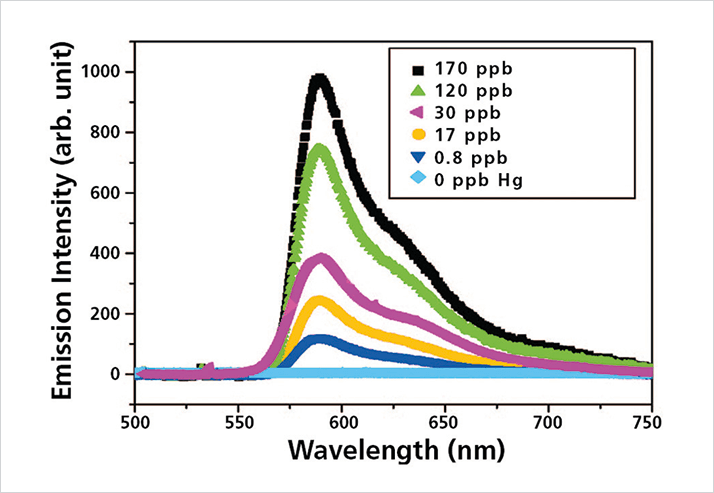Are You Sure You Should Eat That?
Contamination of groundwater, soil and fish with mercury has been increasing steadily for a decade, even in the most remote lakes and wetlands. Excess mercury is a particularly pervasive environmental problem due to its tendency to accumulate in tissue, leading 33 states in the U.S. to issue fish consumption advisories. In fact, 140 countries worldwide have regulations regarding mercury content in food. Ingested mercury acts as a neurotoxin, and can affect growth, development and reproduction. Rapid, accurate and portable measurement of mercury at the ppb level is needed to validate the safety of drinking water and fish destined for human consumption. Most current analytical techniques for quantification, however, are time-consuming and are limited to a lab setting.


No Need to FRET Förster Resonance Energy Transfer (FRET) occurs when two chromophores get close enough to transfer light nonradia-tively. FRET can be used to create sensitive fluorescence assays, but typically offers limited signal and requires an interaction length (chromophore proximity) of <100 Å. Researchers at Jackson State University (Jackson, MS) have found a way to overcome these limitations and achieve a thousand-fold enhancement in fluorescence signal, allowing mercury (Hg) to be measured with a portable system. The researchers created a chromophore pair by adsorbing rhodamine B (RhB) onto a gold nanoparticle surface. While adsorbed, the colloidal gold quenches the RhB fluorescence, a phenomenon they’ve dubbed Nanomaterial Surface Energy Transfer (NSET). In the presence of Hg(II) ions, RhB molecules are released from the gold nanoparticle surface and quickly begin to fluoresce as they bind to the mercury, yielding a signal that correlates directly to the concentration of Hg(II) ions. The sensitivity and range demonstrated are ideal for testing against the U.S. EPA limit of 2 ppb of mercury in drinking water.
It’s Not Just Sensitive; It’s Portable With a 532 nm laser pointer as the excitation source, a 4-way cuvette for the sample holder, and our QE-series spectrometer for detection, the entire system fits into a small case and can be run using battery power and a laptop computer - extremely useful for on-site measurements. The system achieved accuracies of 85-95% for samples of water, soil and fish collected from the Mississippi River, demonstrating its ability to also distinguish between safe and toxic seafood according to the U.S. EPA’s 0.55 ppm standard.
If You Teach a Man to Fish… Just as this technique enables innovative environmental monitoring, it is equally applicable to field detection of other toxins. The enhanced efficiency of NSET over FRET can be applied to detection of biothreat DNA agents such as anthrax, and foodborne pathogens like E. coli, offering tremendous potential for the development of a multitude of biosensors and bioassays to make our world a safer and healthier place.
http://oceanoptics.com/ultrasensitive-detection-mercury-beyond-fret/





